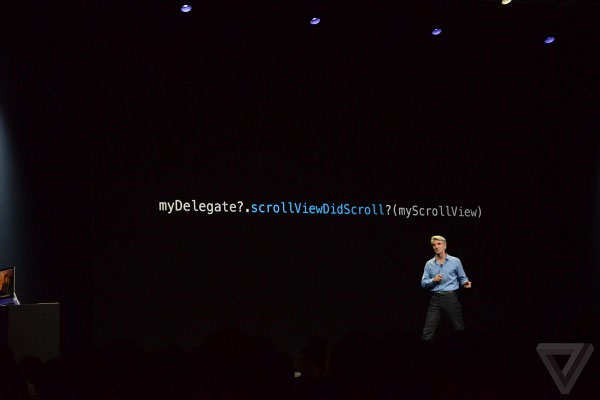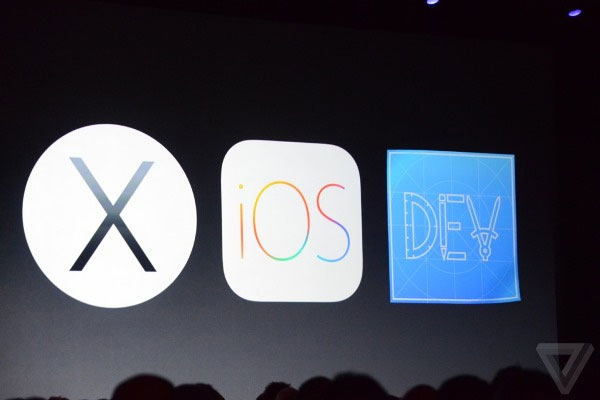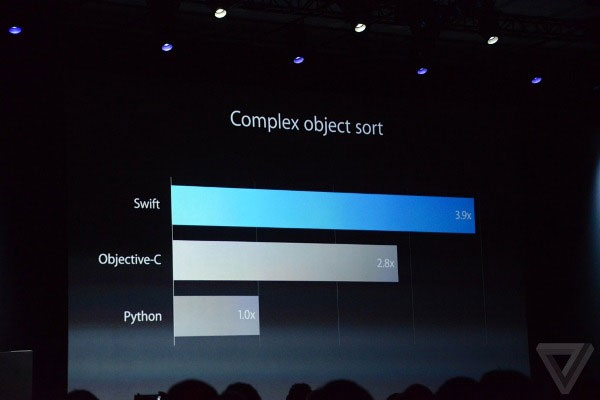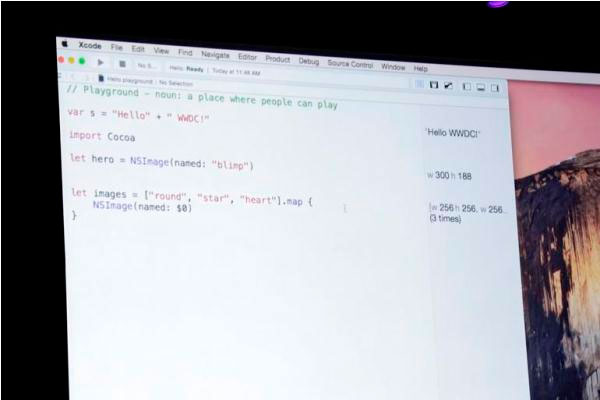What is the Swift programming language? What does it mean for mobile apps?
Surprisingly, at least 99% of Apple fans will never touch one of the biggest products Apple launched at WWDC this year. But, the Swift programming language will still be a very important part of your operating system experience.
After Steve Jobs launched the iPhone at WWDC 2007, the technology community forgot that Apple's Worldwide Developer Conference was an event that focused on . application developers. This is not an event for Apple to focus on launching hardware products, but an event for programmers to come and learn about their new "weapons" in the conquest of the user community. iOS and Mac OS X.
It wasn't until 2014 that Apple brought WWDC back to its true meaning: this is an event for software and software creators.
It is hard to deny that many people are disappointed that WWDC this year did not see any hardware products (iPhone, iWatch, iPad .) at all. But, these people also forget that new operating systems and applications are the most important part of the everyday device use experience. All software released by Apple at WWDC will make it easier for application developers to live. And when their life becomes easier, users will have more applications, the quality of these applications will also become more complete.
The most important disclosure at WWDC this year is Swift, a completely new programming language that can make application development easier, faster and more stable, all to create products. Apps for end users are as good as possible. In short, Swift is designed to meet all "coder" needs. Is this feasible?
Of course, in just one week, we cannot have the most accurate answer. But from what Apple has shown, it is clear that Swift is a very rich programming language. Join us to explore the deep meaning of Swift without reading a single line of code, to understand the vision and vast horizons that new programming languages like Swift can bring.
Low and high-level programming languages

Swift has many outstanding features of the most advanced languages today
There are many ways to order a smart device (laptop, desktop, smartphone, tablet .) to do exactly what you want. The most accurate but complex way is to write command lines with . machine code (binary code) or use assembly code. When writing the assembly code, you will have to write each detailed statement for very small operations, such as changing some of the memory, changing the color of a pixel on the screen . in other words, all the operations The smallest action that hardware can perform.
If you write an Assembly code (or machine code), you can perform the most complex, right-to-expect behavior. But, obviously, when using low-level languages (low-level languages: far from human language and close to machine language) such as machine code or assembly code, application programming becomes extremely boring. , hard and very easy to make mistakes. Writing Safari or even Flappy Bird with Assembly code would be impossible.
Therefore, you will need high-level programming languages. Instead of executing every small command from the programmer, the computer will receive a "high" command from the coder and execute this command itself. High-level languages are similar to human languages in that they have a very clear syntax, with specific limits on the placement of words that language users need to follow.

Swift has a high-level structure: simple, accurate, not redundant lexic or operator
To understand the difference between high-level programming languages and low-level programming languages, imagine when you asked a close friend to give you a Coca can. If you use a high-level programming language, you will say "Hey, throw me a Coca can on the table!" , and this friend will know how to perform this behavior. If you use Assembly language, you will have to say the full paragraph: "Sit up. Put your feet on the floor. Use your hands as a fulcrum. Get up from the sofa. Step one step with your right foot. Step with your left foot "Take the Coca can with your right hand. Turn to me. Take a step with your right foot .".
In short, in low-level languages, you will have to describe all the independent behaviors needed to perform the entire task. Even if you forget to order "use your hand as a fulcrum", your friend (computer) may fall (error) when performing the task.
It is this that forces people to use high-level programming languages. Among high-level programming languages, C is the most "classic" language. This is the ancestor of many other popular programming languages today, from C ++, Objective-C, C # to both Java and PHP. Among the influenced languages / variants from C, Objective-C is Apple's traditional choice and also the foundation for building iOS and Mac OS.
But, when C was up to 40 years old and when Objective-C was 30 years old, Apple needed change. The answer is Swift.

Script programming language
The script programming language, often called scripting language, is becoming more popular than it used to be. Typically, high-level programming languages will need to be compiled into machine code to be able to execute. The compilation process done by the compiler is when high-level statements (such as "getting a Coca can") are converted into small, simple commands that the computer can perform.
Based on the language specific syntax, the commands that human (programmers) can read will be converted into machine code, and if the compilation process succeeds, you will get a real application. the. Note that uncompressed source code files will not make sense to the CPU at all.
However, compiling the source code may take a long time. As mentioned above, if you have not included the source code in the compiler, you will not know whether the code lines you have written actually work perfectly. In many cases, errors in your code will not be detected until the compiler performs its task, and even when compiled, you will have to run the program to detect the errors. rest. All of this makes the software application process very slow.
Script languages are different from these languages. You can run the script you just wrote right away, from one line to the next. You can check your results without waiting for the compilation process. This makes the application development process much quicker and easier.
However, script languages also have their limitations. The first limitation is about functionality: they cannot do complex tasks like other compile languages. Worse, they are limited in processing performance. This makes script languages much more limited than compile languages and is not used to implement programs that require optimal hardware power.
Swift: Perfect programming language?

Swift promises to bring 35% higher performance than Objective C
As such, scripting languages such as Python are easy to write and test (test), but they are not powerful and are not fast enough to perform complex application tasks. In other words, Python is not really suitable for writing heavy games, which require the maximum use of the power of the device. Traditional programming languages (such as Objective-C) provide performance when running on iPhone / iPad, allowing creating complex applications like iMovie or Call of Duty. However, using Objective-C often comes with a large amount of compile time and application testing. Learning to write Objective-C is also a long process, which can be difficult for less experienced programmers.
If all of Apple's promises are fulfilled, Swift will bring all the strengths of both traditional scripting and compile languages. In some benchmark tests, Swift gives faster performance than Python and is even faster than Objective-C. On Apple's Xcode IDE (programming software) suite, Swift source code will be graphed based on real-time playground features. This means that programmers can run and test Swift source code as easily as Python does.
In the example given at WWDC, a programmer took to the stage to perform a graphic of flying up / down for the balloon periodically. To do this, he needs to use a simple mathematical function: sine function. Sin creates a pretty wavy graphics, and so the sine function will be quite perfect for our example.

In the demo stage on the WWDC stage, the Swift programmer was able to impose on the motion of the balloon easily. He can monitor the sine function change value when running his program, based on a simple chart displayed in Xcode. This makes it easy for developers to visualize the movement of the balloon.
In the same examples, you can adjust the movements very easily. Recently, an application developer even uses Swift to create a primitive version of Flappy Bird within . 17 minutes! Usually, the software development process requires programmers to write code, perform compilation (through the compiler), then run the program and . hold their breath hoping. Depending on the size of the application, the process of compiling and testing the application may take a few seconds, a few minutes or longer.
The benefits of Swift

Impressive graphics on iOS 8
The ability to develop mobile applications and test your results in real time will help the programmer's code process become much faster and easier. Also, not having to run compiler programs and testing programs too often will save the hardware power for developers. Instead of focusing on testing, testing small features, Swift programmers can spend more time to perform higher-level integration tests more carefully.
The second benefit of Swift is that the code is very short and easy to read. In Apple's presentation, 3 lines of Objective C code can be encapsulated into 1 line of code Swift. This will accelerate the application development process and increase the efficiency for future maintenance / patching.
Finally and perhaps most importantly, if Swift creates lower-pressure Objective-C hardware hardware applications, we will enjoy a more impressive gaming experience on iOS devices. When combining Swift and Apple's new Metal platform, even the old A7 processor can deliver the most impressive graphics experience.

Swift's weakness
Swift's biggest weakness will be the young age of this programming language. More specifically, to use Swift, developers will have to re-learn a completely new programming language. The technology industry often prefers to master the latest, coolest technologies. However, the iOS application segment has also become so big that thousands of people have spent months to master Objective-C; Objective C training for iOS has become an important industry; There are companies that only focus on this programming language (and iOS). Since Swift will definitely replace Objective-C, iOS application developers will take a considerable amount of time to master Apple's new language. This can reduce the rate of development of Apple application ecosystem.
Another concern is garbage applications. Since Swift will make the application development process much easier than before, the number of poor quality apps that appear on the App Store might increase. However, this is not really a real concern for Apple and Apple users. Through this transition period, Swift will help bring iOS and Mac applications to a new level.
"Hello world" with Swift

Theoretically, Swift is promising to be the "perfect" programming language for application developers. What Apple needs to do is make sure its promises will become reality.
We are so used to technology companies launching impressive numbers as evidence that their products are the best, more advanced than all "old" products and competitors. . But, in the programming world, things are not so simple. It will take a long time for developers to verify what Apple says. It took a long time for the mobile industry to understand the benefits of Swift. This is a huge change, so big that you won't be wrong to say that for the mobile app development industry, Swift is as important as the App Store when it first came out.
You should read it
- Do you know the 15 hottest programming languages on this GitHub?
- 16 most popular, easy-to-find programming languages
- The world's 5 most annoying 'programming languages'
- Set of multiple choice questions about programming with P10 prize
- How to use the Swift programming language in Windows 10
- P13 programming set of multiple choice questions
- Top 5 best programming languages for kids today
- A set of multiple choice questions for programming has a P2 prize
May be interested
- How to turn on the Swift Pair feature in Windows 10
 on windows 10, swift pair is a feature that allows you to quickly connect bluetooth peripherals to a computer. swift pair is available as of version 1803, april 2018 update and is updated with the 20h1 update.
on windows 10, swift pair is a feature that allows you to quickly connect bluetooth peripherals to a computer. swift pair is available as of version 1803, april 2018 update and is updated with the 20h1 update. - Set of multiple choice questions about programming with P12
 the programming test questions below will provide you with useful knowledge on this topic. if you want to study programming, you should not ignore the series of programming tests of network administration.
the programming test questions below will provide you with useful knowledge on this topic. if you want to study programming, you should not ignore the series of programming tests of network administration. - Set of multiple choice questions for programming with P15 prize
 programming is a discipline that attracts many young people interested. not only that job opportunities after graduation with this job are extremely open. so, if you love programming, you should not ignore the following quiz series of network administrator.
programming is a discipline that attracts many young people interested. not only that job opportunities after graduation with this job are extremely open. so, if you love programming, you should not ignore the following quiz series of network administrator. - Want to write applications successfully, apply these 5 principles of Apple
 the secret to programming any application is acceptable on apple's app store.
the secret to programming any application is acceptable on apple's app store. - Do you know the 15 hottest programming languages on this GitHub?
 do you know the 15 hottest programming languages on this github? let's find out in the article below!
do you know the 15 hottest programming languages on this github? let's find out in the article below! - Set of multiple choice questions about programming with P10 prize
 the programming questions below will give you lots of useful information. if you are interested in learning programming languages, the series of programming language topics will be very helpful for you.
the programming questions below will give you lots of useful information. if you are interested in learning programming languages, the series of programming language topics will be very helpful for you. - Set of multiple choice questions about programming with P7 prize
 current programming is no longer strange to us. programming work is becoming hot and more interested. please join the network administrator to learn about programming skills through multiple-choice questions below.
current programming is no longer strange to us. programming work is becoming hot and more interested. please join the network administrator to learn about programming skills through multiple-choice questions below. - Set of multiple-choice questions on award-winning programming P5
 serializing programming tests, in the following article, readers will be able to expand their knowledge with more interesting questions. let's start.
serializing programming tests, in the following article, readers will be able to expand their knowledge with more interesting questions. let's start. - Set of multiple choice questions about programming with P6
 the following network administrators will continue to send you interesting questions about programming. if you love this topic, then try your knowledge.
the following network administrators will continue to send you interesting questions about programming. if you love this topic, then try your knowledge. - P13 programming set of multiple choice questions
 you are a fan of programming languages and want to learn more about this topic. to give you an interesting reading about programming, in this article, the network administrator will send you a good quiz about this topic. invite your reference.
you are a fan of programming languages and want to learn more about this topic. to give you an interesting reading about programming, in this article, the network administrator will send you a good quiz about this topic. invite your reference.










 Google surpassed Microsoft in browser market share
Google surpassed Microsoft in browser market share Microsoft will also have smart watches
Microsoft will also have smart watches Prosecuting two directors of virtual money bitcoin
Prosecuting two directors of virtual money bitcoin Google introduced a new email encryption application
Google introduced a new email encryption application The June update for Windows 8.1 came out
The June update for Windows 8.1 came out The world lost $ 400 billion every year for cybercrime
The world lost $ 400 billion every year for cybercrime